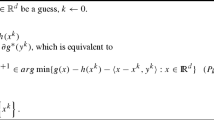Abstract
The uncapacitated multi-facility Weber problem is concerned with locating m facilities in the Euclidean plane and allocating the demands of n customers to these facilities with the minimum total transportation cost. This is a non-convex optimization problem and difficult to solve exactly. As a consequence, efficient and accurate heuristic solution procedures are needed. The problem has different types based on the distance function used to model the distance between the facilities and customers. We concentrate on the rectilinear and Euclidean problems and propose new vector quantization and self-organizing map algorithms. They incorporate the properties of the distance function to their update rules, which makes them different from the existing two neural network methods that use rather ad hoc squared Euclidean metric in their updates even though the problem is originally stated in terms of the rectilinear and Euclidean distances. Computational results on benchmark instances indicate that the new methods are better than the existing ones, both in terms of the solution quality and computation time.
Similar content being viewed by others
References
Wesolowsky G (1993). The Weber problem: history and perspectives. Locat Sci 1: 5–23.
Brimberg J and Love RF (1995). Estimating distances in facility location: survey and applications. In: Drezner Z (ed). Facility Location: A Survey of Applications and Methods. Springer Series in Operations Research. Springer, New York, pp 9–32.
Cooper L (1967). Solutions of generalized location equilibrium models. J Region Sci 7: 1–18.
Eilon S, Watson-Gandy CDT and Christofides N (1973). Distribution Management: Mathematical Modelling and Practical Analysis. Charles Griffin & Company Limited: London.
Megiddo N and Supowit KJ (1984). On the complexity of some common geometric location problems. SIAM J Comput 13: 182–196.
du Merle O, Villeneuve D, Desrosiers J and Hansen P (1997). Stabilization dans le cadre de la génération de colonnes. Les Cahiers du GERAD, University of Montreal.
Krau S (1997). Extensions du problems de Weber. PhD thesis, Ecole Polytechnique de Montreal, Canada.
Hansen P, Jaumard B, Krau S and du Merle O (1997). A column generation algorithm for the multisource Weber problem. Les Cahiers du GERAD, University of Montreal.
Brimberg J, Hansen P, Mladenovic N and Taillard ED (2000). Improvements and comparison of heuristics for solving the uncapacitated multisource Weber problem. Opns Res 48: 444–460.
Cooper L (1963). Location–allocation problems. Opns Res 11: 331–343.
Bongartz I, Calamai PH and Conn AR (1994). A projection method for l p-norm location–allocation problems. Math Program 66: 283–312.
Brimberg J and Mladenovic N (1996). Solving the continuous location–allocation problem with tabu search. Stud Loc Anal 8: 23–32.
Hansen P, Mladenovic N and Taillard ED (1998). Heuristic solution of the multisource Weber problem as a p-median problem. Opns Res Lett 22: 55–62.
Houck CR, Joines JA and Kay MG (1996). Comparison of genetic algorithms, random restart and two-opt switching for solving large location–allocation problems. Comput Opl Res 23: 587–596.
Brimberg J and Mladenovic N (1996). A variable neighborhood algorithm for solving the continuous location–allocation problem. Stud Loc Anal 10: 1–12.
Liu C-M, Kao R-L and Wang A-H (1994). Solving location–allocation problems with rectilinear distances by simulated annealing. J Opl Res Soc 45: 1304–1315.
Gamal MDH and Salhi S (2003). A cellular heuristic for the multisource Weber problem. Comput Opl Res 30: 1609–1624.
Lozano S, Guerrero F, Onieva L and Larraneta J (1998). Kohonen maps for solving a class of location–allocation problems. Eur J Opl Res 108: 106–117.
Hsieh K-H and Tien F-C (2004). Self-organizing feature maps for solving location–allocation problems with rectilinear distances. Comput Opl Res 31: 1017–1031.
Kohonen T (1995). Self-Organizing Maps. Springer-Verlag: Berlin.
Linde Y, Buzo A and Gray RM (1980). An algorithm for vector quantizer design. IEEE Trans Commun COM-8: 84–95.
Weiszfeld E (1937). Sur le point lequel la somme des distances de n points donné est minimum. Tôhoku Math J 43: 355–386.
Wendell RE and Hurter AP (1973). Location theory, dominance and convexity. Opns Res 21: 314–320.
Love RF and Juel H (1982). Properties and solution methods for large location–allocation problems. J Opl Res Soc 33: 443–452.
Love RF and Morris JG (1975). A computation procedure for the exact solution of location–allocation problems with rectangular distances. Nav Res Logist Q 22: 441–453.
Rosing KE (1992). An optimal method for solving the (generalized) multi-Weber problem. Eur J Opl Res 58: 414–426.
Angéniol B, Vaubois C and LeTexier JY (1988). Self-organizing feature maps and the travelling salesman problem. Neural Netw 1: 289–293.
Acknowledgements
This work has been partially supported by the Boğaziçi University Research Fund Grant No. 03HA302.
Author information
Authors and Affiliations
Corresponding author
Rights and permissions
About this article
Cite this article
Aras, N., Özkısacık, K. & Altınel, İ. Solving the uncapacitated multi-facility Weber problem by vector quantization and self-organizing maps. J Oper Res Soc 57, 82–93 (2006). https://doi.org/10.1057/palgrave.jors.2601962
Received:
Accepted:
Published:
Issue Date:
DOI: https://doi.org/10.1057/palgrave.jors.2601962




